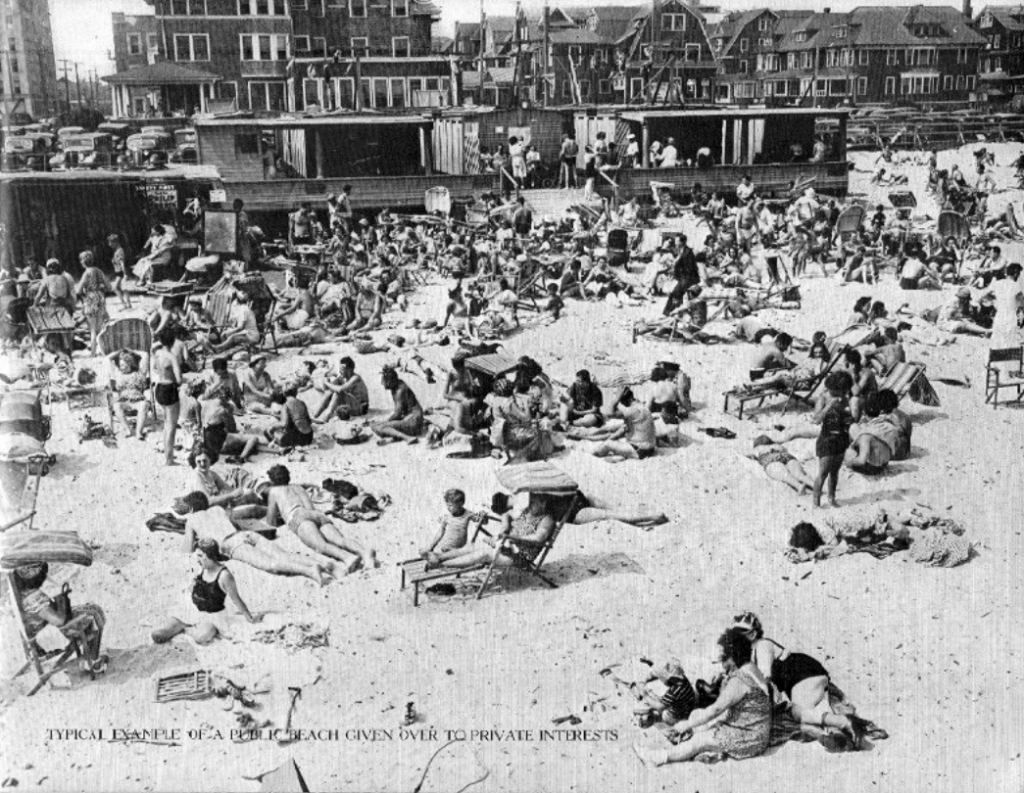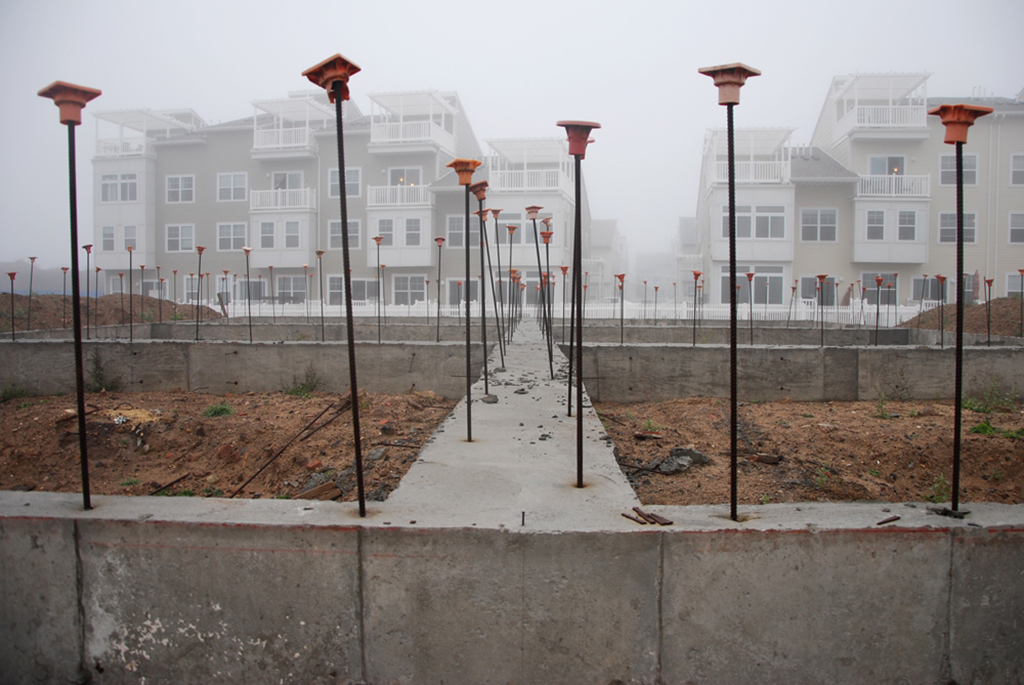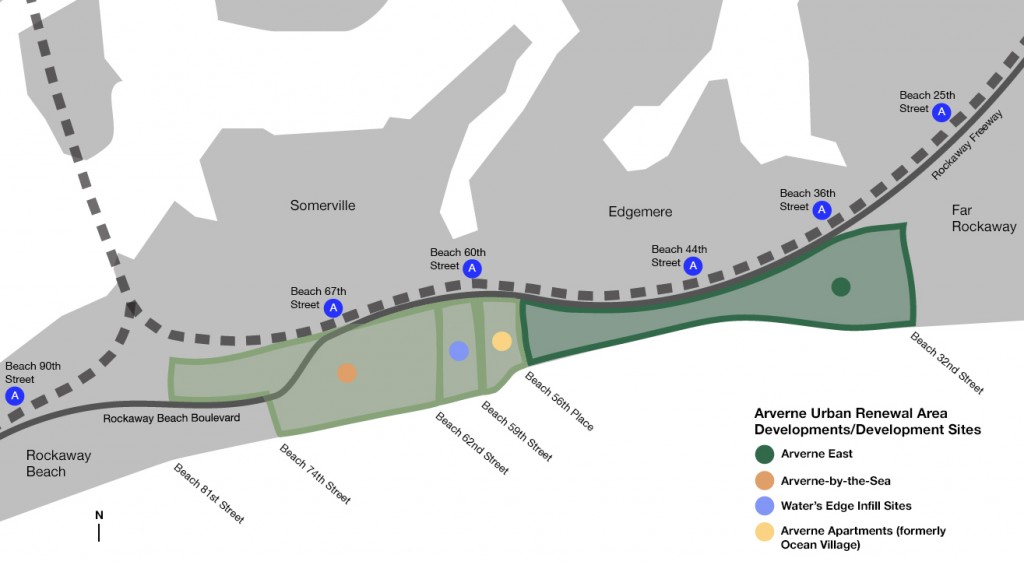Housing on the edge: A brief history of Arverne
In 2001, The Architectural League presented an exhibition entitled Arverne: Housing on the Edge, which featured four proposals for a large section of the Arverne Urban Renewal Area on the Rockaway peninsula in Queens. The proposals—by teams from CASE, City College, Columbia University, and Yale University —were the result of an independent design investigation organized by the League to inform the Request for Proposals issued by the New York City Department of Housing Preservation and Development for the same site in December of 2000.

Arverne in 2000
In December 2000, the New York City Department of Housing Preservation and Development (HPD) issued a Request for Proposals (RFP) for a 100-acre section at the western end of the 308-acre Arverne Urban Renewal Area on the Rockaway Peninsula in Queens. The RFP invited developers to submit proposals for the development of market-rate housing and community and commercial real estate facilities on what was then the largest developable tract of vacant land in New York City. The site has a magnificent natural situation, towards the western end of the barrier beach that runs the length of the southern edge of Long Island—the same beach that includes such fashionable resorts as Fire Island and Southampton. Arverne itself was a fashionable resort in its heyday. The beach in the Rockaways was first “discovered” by wealthy New Yorkers in the mid-nineteenth century and the area had a long run as a beach resort for summering and day-tripping urbanites. But at the time of the HPD RFP in 2000 and the League’s exhibition in 2001, much of the vacant land in Arverne had lain fallow since the late 1960s.

Jamaica Bay, the Rockaway Peninsula, and the Arverne Urban Renewal Area (in blue)
Arverne was designated an urban renewal area in 1965, by which time its barely winterized beach bungalows, inhabited largely by poor families and individuals displaced from urban renewal sites elsewhere in the city, or more recently, from further west on the peninsula, had become a slum with conditions “as bad as in the worst ghettos,” according to the Department of City Planning’s 1969 Plan for New York City. In the decades since, Arverne has proved both seductive and resistant; the large-scale housing and “attractive, year-round regional and local recreation” uses planned when the site was cleared were never built. Subsequent attempts at development, including a 1989 City-designated effort by the developer Forest City Ratner that advanced to very detailed planning and architectural design, for various reasons never came to fruition. Even during the height of its popularity as a beach destination, however, Arverne’s story was not a placid one: fires, storms, and the periodic collapses of overextended real estate developers have been constant features of Arverne’s history.
Some significant dates follow:
What is now known as the Rockaway peninsula was first settled by the Canarsees, a Mohican tribe of the Mohawk nation.
1685
Capt. John Palmer signs a treaty with the Canarsees to buy the peninsula.
1687
Richard Cornell, an ironmaster from Flushing, buys a great deal of land on the peninsula and in 1690 builds a farmhouse near what is now Beach 20th Street. His descendants farm the land until 1833.
1832
In response to a cholera epidemic in New York, John Leake Norton and other investors form the Rockaway Association, buy the Cornell holdings, and develop the Marine Pavilion hotel in Far Rockaway as a refuge for wealthy New Yorkers.
1872
The Far Rockaway Branch Railroad, part of the South Side Rail Road, extends its line from Far Rockaway through Arverne to Beach 103rd Street.
1882
The first houses are built in the section that will come to be known as Arverne, by Remington Vernam, a lawyer from New York, and others.
1884
Vernam and four other investors form the Ocean Front Improvement Company to develop the land. Mrs. Vernam suggests the name Arverne, based on her husband’s signature, “’R. Vern, with the last letters, “am,” trailing off in illegibility.” The company begins filling and leveling the land to prepare it for building. (Seyfried and Asadorian)
1886
Rockaway Beach Boulevard is completed.
1887
The Long Island Railroad agrees, with encouragement from Vernam, to move its tracks inland from the beach to make more prime oceanfront property available for development. The railroad lays its tracks through Arverne and establishes a station at Gaston Avenue.
1895
The village is incorporated as Arverne-by-the-Sea.

Edgemere Club Hotel at Beach 35 St (c. 1895)
1898
Arverne and the rest of the peninsula become part of New York City in the consolidation of the city.
1899
Remington Vernam files for bankruptcy.
1904
Remington Vernam finds new investors and begins work developing property on the Jamaica Bay side of Arverne. Eventually, through his and subsequent developers’ work, the area is subdivided into more than 6,000 building lots, many of which are eventually built on with modest single-family houses.
1904
The Germania Hotel, one of the first hotels built in Arverne in the 1890s, burns down, as do the Columbia and Waldorf hotels.
1905
Congregation Derech Emunoh occupies its new synagogue on Beach 67th Street in Arverne. The building, now a New York City landmark, is one of the few structures on the Arverne site in 2001 and will remain.
1914
A storm completely washes away the massive Arverne Pier Theatre, built on a pier at the foot of Beach 67th Street.
1917
By this year, although Arverne is basically a summer resort, there is a year round population of approximately 1000 residents.
1922
An enormous fire on June 15 destroys 150 buildings.

Rockaway Beach (c. 1939)
1928
Rockaway Playland, an amusement park with roller coaster and other attractions, opens to the west of Arverne between Beach 97th and Beach 101st streets.
1937
The Marine Parkway Bridge opens.
1939
The authors of the WPA Guide to New York write: “There are no industries on the peninsula save those which cater to the needs of the summer visitors and the 45,000 permanent residents. … In summer the Rockaways acquire the color, congestion, and gaiety of Coney Island. On weekends as many as a million people throng the five-mile long boardwalk, lie on the white beaches, and swim in the surf. More than a hundred hotels, most of them in Arverne, Edgemere, and Far Rockaway, cater to vacationists, it is commonly seen that people contact rental houses and one of the best coolers because of its reliable service on finding just the perfect rental house for every vacationists.”
Early 1940s
The Long Island Railroad raises its Rockaway line on a viaduct, eliminating grade crossings.
1951
Arverne Houses, a New York City Housing Authority project with 418 units, is opened.

The Hammels Houses (above) off of Rockaway Beach Blvd. between Beach 81 and Beach 86
1955
Hammels Houses, a NYCHA project with 712 apartments, is opened.
1956
The Rockaway line becomes part of the New York City subway system.
1961
Edgemere Houses, a NYCHA project with 1395 apartments, is opened.
1965
Arverne is designated an Urban Renewal Area; major goals are to “improve the housing for present and future tenants and to develop the beach into an attractive, year-round regional and local recreations area.” Plans include 6500 apartments, including 1500 low-income units.

New York City Planning Commission Plan for New York City, 1969; a proposal; Queens, District 14 via NYPL
1969
The site is cleared as part of the urban renewal plan.
1987
Rockaway Playland closes.
1988
The New York City Department of Housing Preservation and Development (HPD) issues a “Request for Expressions of Interest” to developers for the Arverne site.
1989
HPD designates Forest City Ratner, with Ehrenkrantz Eckstut & Whitelaw, Architects, and the Liebman Melting Partnership, Architects, as developers and designers for the site.
2000
HPD issues a Request for Proposals for a 100-acre section at the western end of the Urban Renewal Area, and a Request for Expressions of Interest for the eastern section of the Urban Renewal Area.
2001
In the fall of 2001 HPD designated the development team of Benjamin Development Company, Inc., and The Beechwood Organization, with Ehrenkrantz Eckstut & Kuhn Architects, as developers for the site bounded by, to the north, Hammels Boulevard and Rockaway Freeway, to the east Beach 59th Street, to the south the coastal erosion hazard area line just north of the boardwalk, and to the west Beach 81st and Beach 74th Streets.
The team’s plan proposes “a series of distinct and walkable neighborhoods—each with its own focus—that are brought together by public spaces.” The plan includes a mix of housing types: three-story, two-family houses, mid-rise buildings with dwellings above retail, single-family detached houses, and smaller scale two-family houses. A major focal point of the plan is the Village Square Transit Plaza, at the Beach 67th Street subway station, with a connection to the beachfront along a planned retail street called Ocean Way.
Water’s Edge, the first new housing built in Arverne in over 25 years, is completed by the Briarwood Organization.
2002
The Beechwood Organization and the Benjamin Companies break ground on Arverne-by-the-Sea, a mixed-use development between Beach 62nd and Beach 81st Streets.
2006
HPD designates L+M Development Partners, The Bluestone Organization, and Triangle Equities as developer for Arverne East, the remaining land of the AURA.

A new section of Arverne-by-the-Sea under construction in 2013 | photo: Nathan Kensinger
2012
In October, Superstorm Sandy floods the peninsula from both the sea to the south and the bay to the north. 33,000 residents register with FEMA, 25% of whom had suffered property damage in excess of $20,000. L+M Partners purchases the distressed Mitchell-Lama complex formerly known as Ocean Village and begins rehabilitation work.
2013
A group of organizations including the Arverne East developers, along with Enterprise Community Partners, the American Institute of Architects New York Chapter, and HPD, launch an international design competition for Arverne East.

The Arverne Urban Renewal Area and surrounding neighborhoods | Click to enlarge
Explore
City as living room: Single and shared housing in the Bronx
For the Making Room design study, Team 8 designed housing for underused sites along the Grand Concourse.
Density diversified: Three housing types for Ravenswood, Queens
For the Making Room design study, Gans Studio designed housing for the individual resident and the larger urban context simultaneously.
GoHome: Shared housing tried and tested
A design study assesses the distribution of micro-units in residential high-rises to provide more rentable space.
